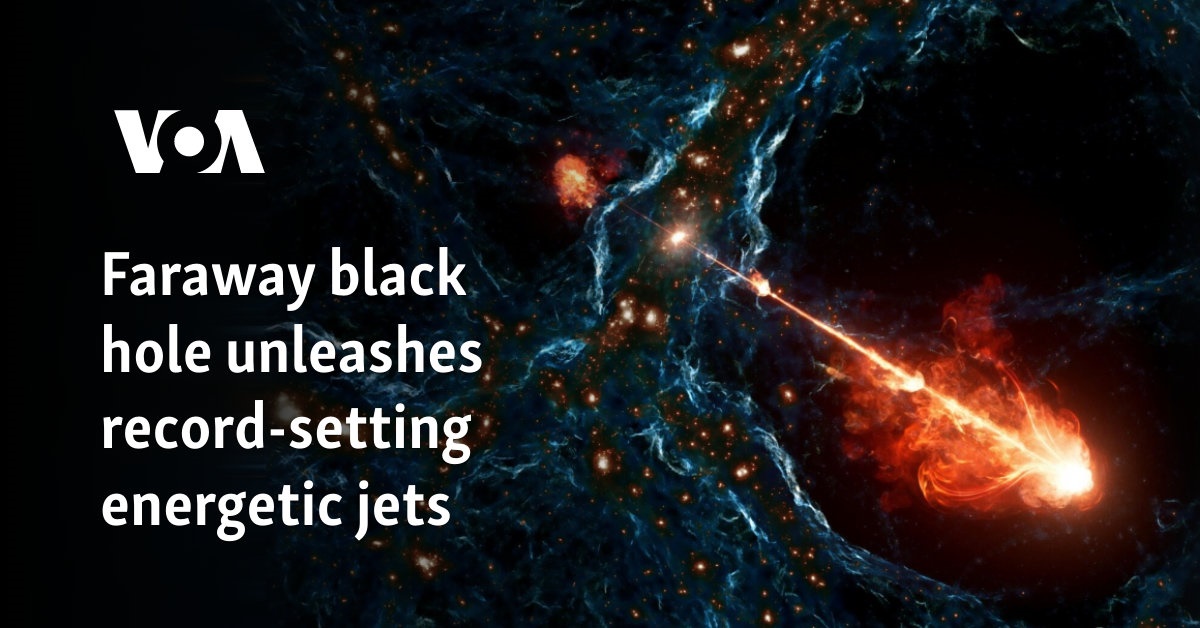Two mighty beams of energy have been detected shooting in opposite directions from a supermassive black hole inside a distant galaxy — the largest such jets ever spotted, extending about 140 times the diameter of our vast Milky Way galaxy.
The black hole resides at the heart of a galaxy about 7.5 billion light-years from Earth. A light-year is the distance light travels in a year, 5.9 trillion miles (9.5 trillion kilometers). Because of the time it takes for light to travel, looking across great distances is peering back in time, with these observations dating to when the universe was less than half its current age.
Black holes are extraordinarily dense objects with gravity so strong that not even light can escape. Most galaxies, including the Milky Way, have a large black hole at their core. Some of these shoot jets of high-energy particles and magnetic fields into space from their two poles as they devour material such as gas, dust and stars falling into them due to their immense gravitational strength.
The two jet structures documented in the new study — using the LOFAR (Low-Frequency Array) radio telescope, a network of antennas centered in the Netherlands — extend 23 million light-years from end to end.
These super-heated jets, caused by the violent events around the black hole, are composed of subatomic particles called electrons and positrons, and magnetic fields, moving at nearly the speed of light.
The researchers have nicknamed these two jets Porphyrion (pronounced poor-FEER-ee-ahn), named after a giant from ancient Greek mythology. Porphyrion is about 30% longer than the previous record-holder for such jets.
“Jet systems like Porphyrion appear to be among the most energetic spectacles that have occurred in the universe since the Big Bang,” said Caltech astrophysicist Martijn Oei, lead author of the study published in the journal Nature, referring to the event that initiated the universe about 13.8 billion years ago.
“The general understanding is that jets are formed when magnetized material falls onto a rotating black hole,” added astrophysicist and study co-author Martin Hardcastle of the University of Hertfordshire in England. “They need to be sustained by a continued infall of matter into the black hole, something of the order of one solar mass [the mass of the sun] a year of material.”
Such jets, not visible to the naked eye, start out small and grow over time.
“We’ve known for a while that black holes can generate these jets. But what is interesting is that to generate a large structure like this, the jets must stay on for a long time — about a billion years,” Hardcastle said.
The Porphyrion jets reach far beyond their home galaxy, with an energetic output equivalent to trillions of stars like the sun.
“That is equivalent to the energy released during the most cataclysmic cosmic collisions: for example, those that occur when two galaxy clusters, each sometimes containing thousands of galaxies, merge together,” Oei said.
“The fact that it extends so far from its parent black hole means that it may be carrying energy, particles and magnetic fields into the voids in the cosmic web, the gaps between groups and filaments of galaxies which we know make up the large-scale structure of the universe. This may help us to understand the ubiquitous magnetic fields in the present-day universe,” Hardcastle said.
Such jets could heat up gas in interstellar space, shutting down the formation of new stars that require cold clouds of gas, and could damage habitable planets, the researchers said.
The Milky Way’s supermassive black hole, in its current quiescent state, does not have such jets.
“The key finding is that jets from black holes can, if circumstances are right, become as large as the universe’s major cosmic structures — galaxy clusters, cosmic filaments, cosmic voids,” Oei said. “This means that individual black holes can have a sphere of influence that extends way beyond the galaxy in which they reside.”






